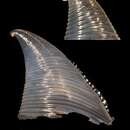en
names in breadcrumbs


Carinaria cristata ist eine pelagisch lebende Art von Schnecken aus der Gruppe der Kielfüßer (Schwimmfüßer).
Carinaria cristata ist die größte von sechs Arten der Gattung Carinaria. Während Carinaria cristata bis zu 68 cm lang werden kann, erreicht die nahe verwandte Art (oder Unterart) Carinaria japonica eine Maximalgröße von 15 cm.
Das Gehäuse ist konisch, papierdünn, durchscheinend und in noch frischem Zustand biegsam. Die Schale ist wie eine Zipfelmütze geformt und seitlich abgeflacht, mit kleiner, nach hinten gerollter Spitze. Die Rippen sind glatt, gewellt und konzentrisch und verlaufen bis zu einem Kiel, der von innen gut sichtbar ist.
Die Schnecken sind getrenntgeschlechtlich. Der lange, zylindrische Körper hat eine Schwimmflosse und ist nahezu gänzlich durchsichtig. Er kann zu keinem Zeitpunkt ins Gehäuse zurückgezogen werden. Deutlich sichtbar sind der dreieckige, dunkel gefärbte viscerale Nucleus (Eingeweidesack mit Leber, Hoden bzw. Eierstock, Herz und Nieren), die großen Augen mit ihrer schwarzen Retina, die Kiefer und die Radula, ebenso der Darm, wenn er mit Beutetieren gefüllt ist. Die Zahnformel der Radula von Carinaria cristata lautet 2-1-1-1-2.
Carinaria cristata kommt in warmen bis gemäßigten Gewässern des Indopazifik vor. Die Tiere leben in den oberen Schichten des Meeres, wo sie sich schwimmend fortbewegen. Wie alle Schwimmfüßer schwimmt das Tier mit der Unterseite nach oben.
Carinaria cristata frisst überwiegend Salpen (Doliolum denticulatum, Thalia democratica), außerdem Pfeilwürmer (Sagitta spp.) und planktische Schnecken (z. B. Thecosomata), wobei Kannibalismus vorkommen kann, daneben auch Krebse (Krill, Ruderfußkrebse) sowie zu einem kleineren Anteil Nesseltiere (kleine Staatsquallen: Nanomia bijuga, Muggiaea atlantica) und Fische (Larven von Laternenfischen). Die Beutetiere sind typischerweise halb so lang wie der Räuber. Sie werden als Ganzes verschluckt und im Vorderdarm verdaut, wobei die Verdauungszeit etwa 3 bis 4 Stunden beträgt. Die Schnecke ist überwiegend tagaktiv, möglicherweise weil sie ihre Beute mit den Augen ortet.[1]
Die wichtigsten Feinde von Carinaria cristata sind Fische, darunter Thunfische, sowie Schildkröten.[2]
Die Schale von Carinaria cristata wurde von Carl von Linné 1767 in der 12. Ausgabe des Systema Naturae unter dem Namen Patella cristata als eine Napfschnecke beschrieben.[3] Johann Friedrich Gmelin nennt das Tier 1791 Argonauta vitreus („Gläserner Argonaut“) und ordnet es somit den Papierbooten, also Kopffüßern zu.[4] Jean-Baptiste de Lamarck stellte 1801 den Namen der Schneckengattung Carinaria auf und ordnete ihr auch diese Art unter dem Namen Carinaria vitrea zu.[5]
Carinaria cristata ist eine pelagisch lebende Art von Schnecken aus der Gruppe der Kielfüßer (Schwimmfüßer).
Carinaria cristata, commonly known as the glassy nautilus,[2] is a species of pelagic marine gastropod mollusc in the family Carinariidae.[3] It is found in the Pacific Ocean and is described as being holoplanktonic, because it spends its entire life as part of the plankton. It was first described by Carl Linnaeus in 1767. Its fragile shell was much prized by early conchologists for their collections, being so rare that it was said to be worth more than its weight in gold.[4]
Carinaria cristata is a very large gastropod mollusc that can reach a length of 50 centimetres (20 in). The shell is a ribbed, cap-shaped cone, about as wide as it is long. It is relatively small, and the body is too large to retract inside it. The body consists of a short proboscis, a central portion and a crested tail. The whole is roughly cylindrical and has a swimming fin on the opposite side from the shell, with a small sucker on its edge. The gelatinous body is translucent, and the gut and its contents can be seen through the body wall. The retinas of the eyes are visible as two black spots. The visceral nucleus, which includes the liver, heart, gonad, sexual glands and kidneys, is a dark, stalked, triangular area protected by the shell, which also houses the gills.[5][6]
There are two forms of this species, Carinaria cristata form cristata, and Carinaria cristata form japonica. The former is found in the Indo-Pacific region while the latter is found only in the Pacific. It is uncommon in the Indian Ocean but more plentiful in warm waters off the western coast of North America.[5]
Carinaria cristata is carnivorous and is an opportunistic predator. Although its diet is varied, it feeds selectively on salps and doliolids, but also consumes arrow worms and copepods. The copepods are eaten to a much smaller extent than their proportion in the planktonic community would suggest. Other prey includes siphonophores, planktonic worms, fish eggs and larvae, and juveniles and smaller adults of its own species.[7] The food is ingested whole and retained in the oesophagus where it is digested by enzymes secreted by the salivary glands. [8]
C. cristata is eaten by a number of predators including turtles and tuna.[7]
Carinaria cristata, commonly known as the glassy nautilus, is a species of pelagic marine gastropod mollusc in the family Carinariidae. It is found in the Pacific Ocean and is described as being holoplanktonic, because it spends its entire life as part of the plankton. It was first described by Carl Linnaeus in 1767. Its fragile shell was much prized by early conchologists for their collections, being so rare that it was said to be worth more than its weight in gold.
Carinaria cristata is een slakkensoort uit de familie van de Carinariidae.[1] De wetenschappelijke naam van de soort is voor het eerst geldig gepubliceerd in 1767 door Linnaeus.
Bronnen, noten en/of referenties龙骨螺(学名:Carinaria cristata),是中腹足目龙骨螺科Carinaria的一种。主要分布于中国大陆,常栖息在浮游生活。[1]

ゾウクラゲ(象水母)は、腹足綱のゾウクラゲ科またはハダカゾウクラゲ科に属する軟体動物の総称、またはゾウクラゲ科の一種(Carinaria cristata )を指す。名前にクラゲとあるが軟体動物である巻貝の仲間であり、刺胞動物や有櫛動物に属するいわゆるクラゲとは系統的に異なる。本項ではゾウクラゲ科の一種(Carinaria cristata)について解説する。
本項の分類は Bouchet & Rocroi(2005) にしたがった。
本種には外部形態の異なる二つの型が記載されている(C. cristata forma cristata, C. cristata forma japonica)。 大型の腹足類で、f. cristata は50cmに、f. japonica は15cmに達する。ゼラチン質の体は長円筒形で全身がほぼ透明になっている。背中の内臓核(肝臓・心臓・腎臓・生殖腺・鰓を含む)は暗色を呈する。殻は本体に対して非常に小さく、この内臓核を覆うように配置されている。殻の反対側には一枚の遊泳用の鰭があり、尾部の背側には稜が発達している。頭部には短い吻があり、目の網膜は二つの黒い斑点として見ることができる。消化管は透明で、消化中の獲物は外から観察可能である。f. japonica の殻は正三角形に近く、尾部の稜はラマルクゾウクラゲに似た三角形になっている。[2][3]
本種は沿岸および外洋の浅い暖水域を漂っている。日和見的な捕食者で、選択的にサルパ類やウミタル類を捕食するが、ヤムシ類やカイアシ類を捕食することもある。カイアシ類は海中に棲息するプランクトン中に占める割合を考慮すると非常に少ない量しか捕食されていない。他にはクダクラゲ類、魚卵や仔稚魚、同種の稚貝や体の小さな成体が獲物として報告されている[4]。 獲物は丸呑みにされ消化管にとどまり、唾液腺から分泌される酵素により消化される [5]。 本種にはウミガメ類やマグロ類など多くの天敵がいる[4]。
f. cristata はインド洋、太平洋の暖水域(インド太平洋)に分布するがインド洋での記録は稀である。f. japonica は f. cristata よりも広温性のようであるが、分布は太平洋に限られる[2]。
(地図 f. cristata f. japonica)